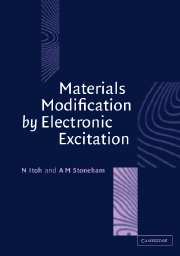Book contents
- Frontmatter
- Contents
- Preface
- 1 Concepts: Excitation, polarons and electronic structure
- 2 Energy deposition and redistribution in solids
- 3 Electron–lattice coupling and its consequences
- 4 Self-trapping
- 5 Local lattice modification by electronic excitation of halides
- 6 Local lattice modification by electronic excitation of crystalline insulating oxides
- 7 Local lattice modification of semiconductors by electronic excitation
- 8 Local lattice modification of amorphous materials by electronic excitation
- 9 Atomic emission and surface modification
- 10 Interface reactions induced by electronic excitation
- 11 High excitation intensities
- 12 Applications of materials modification by excitation
- References
- Index
9 - Atomic emission and surface modification
Published online by Cambridge University Press: 11 August 2009
- Frontmatter
- Contents
- Preface
- 1 Concepts: Excitation, polarons and electronic structure
- 2 Energy deposition and redistribution in solids
- 3 Electron–lattice coupling and its consequences
- 4 Self-trapping
- 5 Local lattice modification by electronic excitation of halides
- 6 Local lattice modification by electronic excitation of crystalline insulating oxides
- 7 Local lattice modification of semiconductors by electronic excitation
- 8 Local lattice modification of amorphous materials by electronic excitation
- 9 Atomic emission and surface modification
- 10 Interface reactions induced by electronic excitation
- 11 High excitation intensities
- 12 Applications of materials modification by excitation
- References
- Index
Summary
Energy absorption near surfaces
Electronic excitation at solid surfaces can be induced in two main ways. The first is electronic excitation in the bulk, followed by direct energy transfer or by the diffusion of excitons or of electron–hole pairs to the surface. The second route involves the excitation of surface states or surface defect states. Such states are especially important when the excitation energy is less than the bulk bandgap. However, the division into two classes is not clear-cut, for there will usually be a space-charge region of a few nanometres in thickness; energy absorption in this region may make an important contribution to near-surface excitation. De-excitation processes at surfaces may follow the same pattern as in the bulk. The modification of local surface structures will often be simpler and easier than in the bulk. What will be different are reactions involving specific surface species, including adsorbed species, and processes which involve the emission of atoms, ions, or molecules. Our emphasis on the modification of the underlying material continues. We shall therefore note, but say little about, processes such as the laser removal of silicon chloride species during plasma etching (C C Cheng et al. 1994).
Several terms are used for the emission of atoms or ions, depending on the rate and the application: desorption; sputtering; ablation. In this book, desorption usually refers to reemission of adsorbates on surfaces, whereas sputtering is the emission of atoms or ions constituting the host material.
- Type
- Chapter
- Information
- Materials Modification by Electronic Excitation , pp. 325 - 378Publisher: Cambridge University PressPrint publication year: 2000

